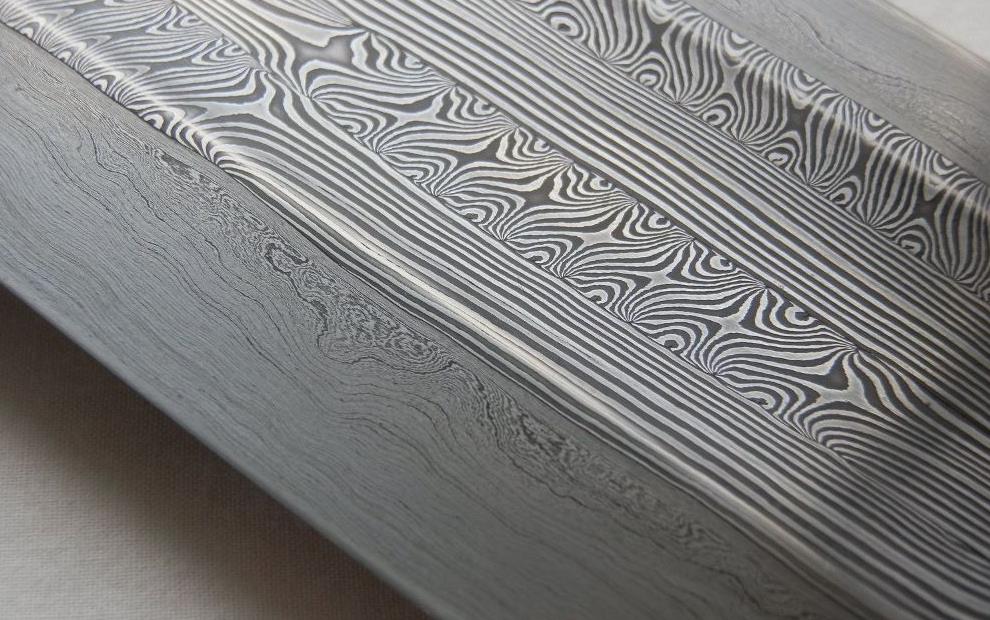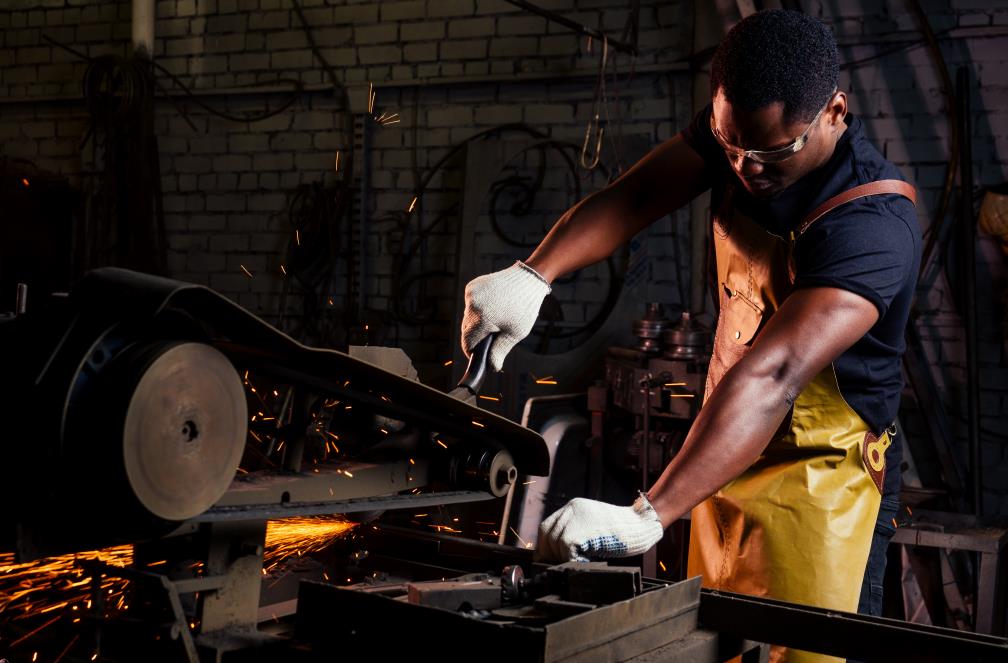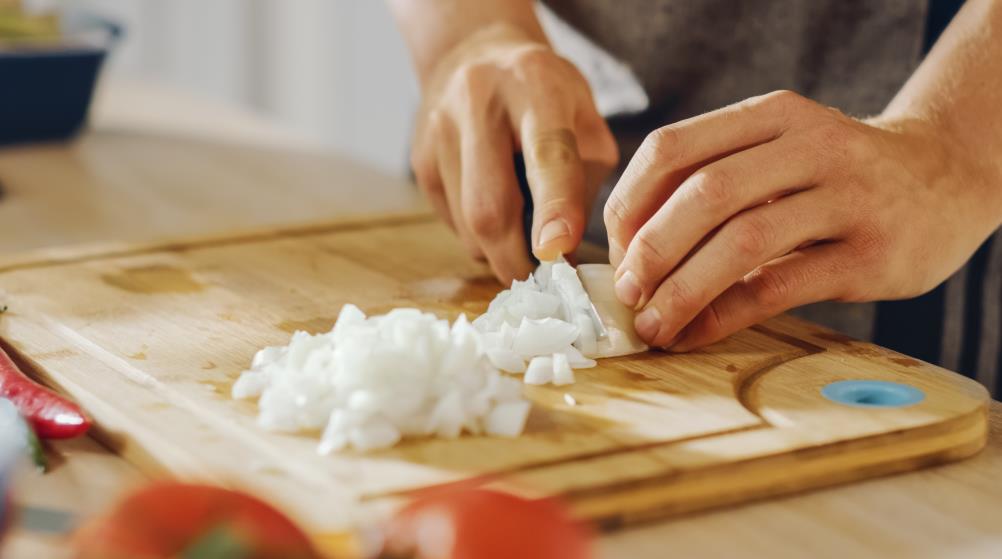The intricately defined patterns you sometimes spot on knives are more than what meets the naked eye. While it is true that these beautiful patterns add a distinct aesthetic touch to knives, they also offer functional benefits that make them more than just beautiful works of art.
These wavy patterns form due to a process called pattern welding. Pattern welding is said to be the tie-dye of the knife world. It is a unique method that involves forge-welding iron and steel parts of different compositions.
These forge-welded parts are then twisted together in such a manner that an intricately beautiful pattern faintly emerges on the blade. Next, strong acids enhance these patterns in a process known as acid etching.
Let us learn all about pattern welding and whether such knives are suited for the modern culinary world.
Table of contents
What is pattern welding?

Pattern welding refers to the unique process of forging knives and swords by using metals of differing compositions and then twisting them to create a characteristic wavy pattern.
These patterns form partly because sufficiently differing metals that intersect the surface reflect lights differently. The pattern will then be revealed after the acid etching process.
Furthermore, steels reveal different colors from heat treatment. The various colors emerge because those steel have differing levels of corrosion resistance that react differently to heat and reveal lighter or darker colors, respectively.
The history of pattern welding dates back as early as the 2nd century AD. The Celts were believed to be the first to exhibit this technique of forging swords, followed by the Germanics. By the 3rd century AD, Romans, Celts, and Germanics used this technique for aesthetics and functional benefits.
The technique evolved due to a need for more robust, durable, and tougher blades that conventional iron smelting failed to provide.
Modern pattern welding technique on steel
Does pattern welding serve a better purpose, or is it merely bought for its aesthetic beauty?
As discussed, the different patterns that you find on pattern-welded steel result from forging different steels together. This steel mixing was primarily done to benefit from the different properties such steels possessed.
Blacksmiths created purposeful steels with this method. It was one of the best steels made during their time. While people might think that humankind eventually stopped producing this steel due to the tedious process involved, the truth is that modern steel advancements have deemed pattern-welded steel obsolete. Knife users today often buy them for their rich history, personal style, and aesthetics rather than functional purposes.
Pattern welded vs. Damascus steel.
Pattern welded steel has been around for centuries, describing two or more steels forged-welded together to create distinctive patterns.
Historically, Damascus steel referred to the patterned steel from the area around Damascus, known as Wootz steel which isn’t found anymore. Modern Damascus steel, similarly, employs pattern-welded steel as the primary manufacturing method to produce them. Therefore, it can be said that pattern-welded steel and Damascus steel are the same.
The process of pattern welding

Pattern welding technique has been used to produce the beautiful modern-day Damascus steel. The technique is an extensive process that creates a strong, hard, and flexible steel.
Knifemakers choose two or more different sheets of steel that allow the creation of an intricately beautiful pattern. The steels are stacked against one another to create billets. These billets are then twisted and folded together, followed by heating and hammering.
When the billets have been adequately folded and hammered, the steel is hardened to form a structure by quenching. The shaping process is completed by hammering the steel, lengthening it, and flattening it.
Lastly, the annealing and etching processes are done, which involve submerging the blade in an acid that reacts differently with the different steels to reveal a beautiful, unique Damascus pattern.
Is Damascus steel a good choice for kitchen knives?
Now that you have understood how modern Damascus knives are created, you will have a fair idea about whether these knives will make good kitchen tools. The answer largely depends on the steel used for forging together a Damascus. Other factors include steel properties and heat treatment being used by the manufacturer.
What’s more, they will look really beautiful too.
Damascus steel vs. carbon steel
When looking for a good quality kitchen knife, knife users often face confusion about choosing between Damascus steel and the famous regular carbon steel. The truth is, both of these types make for good, strong, and durable kitchen knives. Nevertheless, the following are the differences between them:
Hardness
A primary determinant when choosing a good quality kitchen knife is hardness. That said, the alloy that grants maximum hardness to any steel is carbon. High carbon steels generally have more carbon than their Damascus counterparts, and is more ‘pure’ in composition. That makes them harder.
If you look at both of the steel blades on average, you will find that most Damascus blades have a Rockwell Hardness level somewhere in the mid 50s while high carbon steel in the high 50s or 60s range.
Edge retention

Carbon steel will give you superb cutting performance with its incredibly sharp edge, hard steel, and long edge retaining capability. Such harder steels offer better edge retention when properly heat treated and tempered. Heat treating and tempering ensure that hardness doesn’t make the blade brittle.
Regarding Damascus’ performance, it can be said that Damascus will perform nearly at par with carbon steel and hold an edge adequately, considering it includes a mix of other alloys. This mix of alloys offers flexibility alongside hardness so that you will have an easier time working with hard ingredients.
Nevertheless, you can expect high carbon steels to give you better edge retention than most Damascus steels.
Corrosion resistance
Mostly, you can expect better corrosion resistance from Damascus blades than high carbon ones. Damascus steel employs a blend of different alloys that contribute to its corrosion resistance, unlike a high carbon steel blade.
Properly cleaning, drying, and sharpening your knives will allow both kinds of steel to be kept for longer.
Aesthetics
Damascus steel is made by combining different steels and then forged together. This forging technique, in turn, grants it beautiful wavy patterns and also makes it a signature knife. On the other hand, carbon steel and stainless steel have plain surfaces. In terms of aesthetics, Damascus steel is clearly the winner.
As can be seen, there is no winner here. It all depends on the purpose of the knife and the knife user’s needs and preferences that will help them decide which one to choose.
How to tell if the Damascus blade is real?
Impulsively buying some Damascus blades that you found at a new store or website? Here are the things you must look out for to ensure that no one robs you of your hard-earned money:
Pattern uniformity
An authentic modern-day Damascus blade will be made of different steels throughout the blade. This implies that a unique pattern will be visible on the blade that is uniform and consistent throughout its entirety.
If different patterns show on different parts of the blade, be wary as something is wrong. However, sometimes knife makers do polishing to remove patterns from some blade parts. This pattern removal is done to distinguish certain blade parts.
Therefore, if patterns aren’t visible on some parts of the blade, it doesn’t make the blade fake itself. The key is to look for uniformity and spot different patterns, if any. It will help you identify a real Damascus blade from a fake one to a certain extent.
Price
No sale or discount offer can help you buy a real Damascus blade as cheap as $10 or even 20. This is because Damascus blades are labor-intensive and require real skill and expertise. These factors make the Damascus blade come at a higher price tag.
If someone is offering you a Damascus blade at an astonishingly cheap rate, it’s better to stay away.
Acid etching
Lastly, to identify whether your Damascus blade is authentic, you can perform acid etching on it yourself. It would be best to sand the entire blade with sandpaper to remove the patterns. Once clean and dry, dip only the blade in ferric chloride or muriatic acid for about fifteen minutes.
Patterns appearing on the blade means you have got the real Damascus steel. In case of random layers or discoloration, better to return the blade!
Final verdict
No two pattern welded knives are the same. That said, pattern-welded steel is not entirely a thing of the past and is still being used to make some fine quality knives. If you are still confused, you might want to try our hand-forged, high-performance knives from HDMD. Check them out now!









